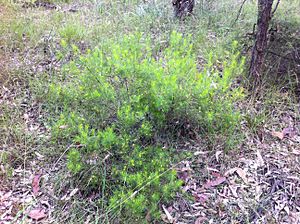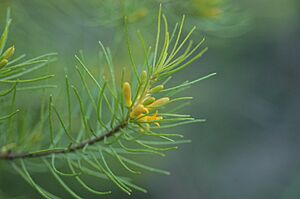North Rothbury persoonia facts for kids
Quick facts for kids North Rothbury persoonia |
|
|---|---|
 |
|
| Conservation status | |
| Scientific classification | |
| Genus: |
Persoonia
|
| Species: |
pauciflora
|
The North Rothbury persoonia (scientific name: Persoonia pauciflora) is a special plant found only in a small part of New South Wales, Australia. It belongs to the Proteaceae plant family. This plant is a small, spreading shrub with bright green, thin leaves. It produces a few yellow flowers, mostly in summer.
Scientists only recently described this plant. It looks a bit like another plant called P. isophylla, but it has fewer and shorter flowers. Because it grows in such a tiny area, the Australian government has listed it as "critically endangered." This means it's at very high risk of disappearing forever.
Contents
What Does the North Rothbury Persoonia Look Like?
The North Rothbury persoonia is a shrub that spreads out. It usually grows to be about 100 to 140 centimeters (around 3 to 4.5 feet) tall. It can spread out from 40 to 200 centimeters (about 1.5 to 6.5 feet) wide. When the plant is young, its leaves and branches are a bit hairy. Its bark is smooth and grey. The leaves are a bright green color, very thin like threads, and measure about 17 to 35 millimeters (0.7 to 1.4 inches) long. They are less than 1 millimeter (0.04 inches) thick.
Flowers and Fruit
This plant can flower all year round, but it blooms the most from January to April. It doesn't have many flowers. They grow in small groups of up to nine, usually near the ends of the branches. Each flower sits on a slightly hairy stalk that is about 1 to 2.5 millimeters long.
Each flower has a tube-shaped part called a perianth. This perianth splits into four sections, called tepals. Inside, the flower has both male and female parts. The central part is called the style. Around the style are the anthers, which are the male parts. When the anthers split, they curl back and look like a cross from above. This shape helps insects land on the flower. The stigma, which is the female part, is at the very tip of the style. The tepals are dull yellow, slightly hairy, and measure about 4.5 to 8 millimeters long.
After the flowers bloom, the plant produces fruit. These fruits are green or reddish-green, oval-shaped, and smooth. They are a type of drupe, which means they have a hard pit inside, like a peach. The fruits are about 9 to 11 millimeters long and about 15 millimeters wide.
How Was This Plant Named?
In September 1997, a plant expert named Gordon Patrick found this unknown shrub in the North Rothbury area of the Hunter Valley. In January 1998, Patrick and another expert, Peter Weston, collected a sample of the plant. This sample became the "type specimen," which is like the official example of a new species. They placed it in the New South Wales Herbarium.
In 1999, Peter Weston officially described the new species as Persoonia pauciflora. This description was published in a science journal called Telopea.
Meaning of the Name
The first part of the plant's scientific name, Persoonia, honors a South African botanist named Christiaan Hendrik Persoon. The second part, pauciflora, comes from two Latin words:
- paucus, meaning "few" or "little."
- flos, meaning "flower" or "blossom."
So, pauciflora means "few-flowered," which describes how this plant has a small number of flowers. This helps tell it apart from other plants in the same group.
Plant Family Connections
The North Rothbury persoonia belongs to a group of 58 closely related Persoonia species. They all have similar flowers but very different leaves. These species often interbreed (mix their genes) if they grow in the same area. Based on its leaf shape, the North Rothbury persoonia seems most closely related to Persoonia isophylla and Persoonia pinifolia. However, unlike those two species, it prefers to grow in heavier, clay-based soils, not sandy soils.
Where Does the North Rothbury Persoonia Live?
The North Rothbury persoonia is only found in the North Rothbury area of New South Wales. It grows in dry sclerophyll forests or woodlands. These forests have trees like broad-leaved red ironbark (Eucalyptus fibrosa), grey box (E. moluccana), grey gum (E. punctata), and spotted gum (Corymbia maculata). Underneath these trees, there are many shrubs and grasses.
This plant lives in a very small area, covering only about 2.5 square kilometers (about 0.97 square miles). All the plants found so far are within 2.5 kilometers (about 1.5 miles) of where the first one was discovered.
Life Cycle and Reproduction
Unlike some other plants, the North Rothbury persoonia does not have a special woody swelling at its base called a lignotuber. This means it probably cannot regrow from its roots after a fire. Instead, it likely relies on seeds to reproduce. New plants grow from seeds that can stay in the ground for a long time.
Plants need to be at least 18 months to 3 years old before they can produce healthy seeds. They typically live for about 7 to 12 years. Many different kinds of insects visit the flowers, but scientists are not sure exactly which insects help pollinate them.
Seed Dispersal and Germination
It is believed that large birds, like currawongs, and bigger mammals eat the fruit of the North Rothbury persoonia. When these animals eat the fruit, they then spread the seeds in their droppings. The seeds have a very hard outer coat. Scientists don't know exactly what makes the seeds sprout, but new plants often appear after heavy rain.
Researchers at the Mount Annan Botanic Garden are studying how persoonia seeds sprout. They once found that a bowerbird was taking the fruit of P. pauciflora from their experiments. This observation might help them understand how bird droppings could help the seeds grow.
Why Is This Plant Endangered?
The North Rothbury persoonia is in serious trouble. In 2016, fewer than 400 mature plants were left, along with about 107 younger plants. This small number makes it very vulnerable.
The biggest dangers to this plant include:
- Habitat Loss: Land is being cleared for new houses and buildings, destroying the places where the plant lives.
- Habitat Fragmentation: The plant's living areas are being broken up into smaller, separate pieces. This makes it harder for the plants to spread and for animals to move seeds around.
- Illegal Clearing and Picking: Some people illegally remove plants or clear land where they grow.
- Habitat Damage: Grazing by animals and slashing (cutting down plants) can also harm the plant's environment.
Because of these threats, the North Rothbury persoonia is listed as an "endangered species" under New South Wales law. It is also classified as "critically endangered" by the Australian Government. This means it needs urgent protection to survive.



